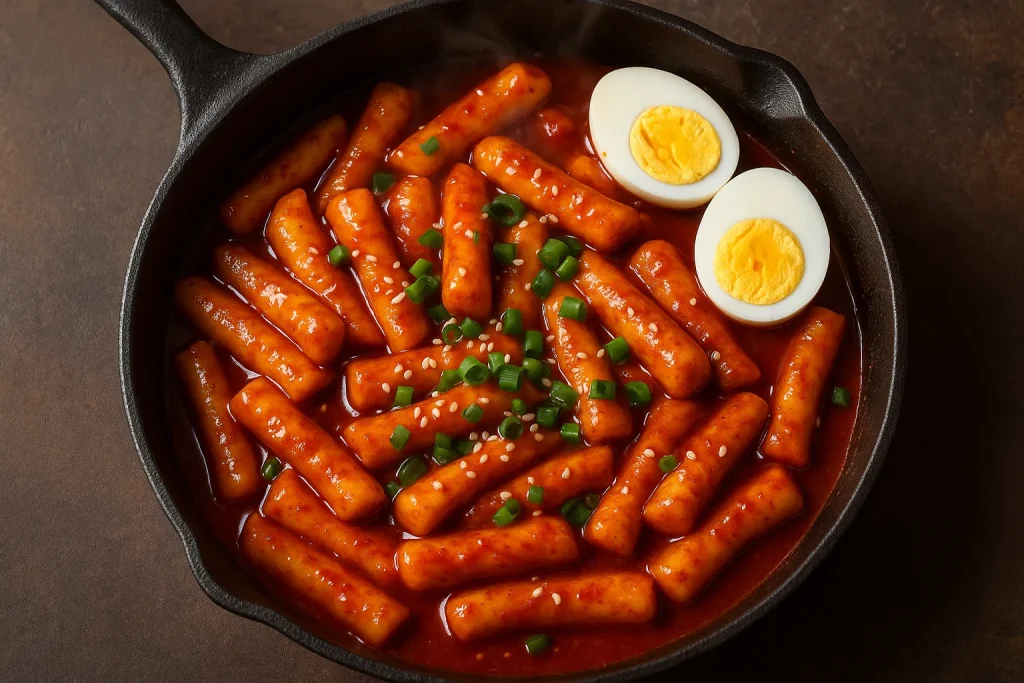Vegan Jjajang Tteokbokki: Korean Black Bean Rice Cake Recipe

Looking for something savory, rich, and deeply satisfying? Vegan Jjajang Tteokbokki combines the chewy, addictive texture of Korean rice cakes with the bold umami of jjajang (black bean) sauce—all without any animal products. This fusion dish is cozy, hearty, and packed with flavor, making it a perfect plant-based comfort meal that’s easy to whip up at home.
A Flavorful Twist on a Korean Classic
Tteokbokki is a beloved Korean street food typically served in a spicy red gochujang sauce. This version uses jjajang, a black bean paste sauce popular in Korean-Chinese cuisine, for a savory and slightly sweet take that’s both unique and incredibly satisfying. It’s the ultimate comfort food—deeply flavorful, warming, and completely vegan.
Simple Ingredients, Deep Flavor
Don’t be fooled by the deep, rich taste—this dish comes together with simple, pantry-friendly ingredients. The key is chunjang (Korean black bean paste), which delivers that earthy, slightly smoky flavor. Paired with vegetables, a touch of sweetness, and chewy rice cakes, it’s a flavor bomb in a bowl.
- 1½ cups Korean rice cakes (tteok, oval or cylinder shape)
- 2 tbsp Korean black bean paste (chunjang)
- 1 tbsp neutral oil
- 1 tsp sugar
- 1 tbsp soy sauce
- 1 tsp rice vinegar (optional, for balance)
- 1½ cups water or veggie broth
- ½ onion, diced
- ½ zucchini, sliced
- ¼ cup cabbage, chopped
- Green onion for garnish
Nutritional Benefits
This dish is rich and satisfying but still aligns with plant-based eating. Rice cakes provide complex carbs, and the veggies bring fiber, vitamins, and texture. Using minimal oil and no animal products, it’s a cleaner take on a Korean comfort classic.
- Calories: ~260
- Carbs: 48g
- Protein: 4g
- Fat: 4g
- Fiber: 3g
- Sodium: ~500mg
Timing Breakdown
This recipe is weeknight-friendly and comes together quickly. Prepping your veggies ahead of time makes the whole process smooth and easy.
- Prep Time: 10 minutes
- Cook Time: 15 minutes
- Total Time: 25 minutes
How to Make Vegan Jjajang Tteokbokki

This one-pan dish is simple, flavorful, and perfect for sharing (or hoarding for yourself!). The sauce thickens as it cooks, coating the rice cakes in velvety, savory richness.
- Soak rice cakes in warm water for 10–15 minutes if they’re refrigerated or frozen.
- Sauté onion in oil over medium heat until translucent. Add zucchini and cabbage, cook for 2–3 more minutes.
- Push veggies aside, add chunjang and sugar directly to the pan. Let the paste toast for 1–2 minutes to mellow bitterness.
- Mix everything together, then add water or broth, soy sauce, and vinegar.
- Add rice cakes and simmer for 8–10 minutes, stirring often, until sauce thickens and rice cakes are tender.
- Garnish with green onions and serve hot.
Healthier Ingredient Swaps
You can tweak this recipe to suit your taste or dietary preferences while keeping all the savory satisfaction.
- Use low-sodium soy sauce for less salt
- Add tofu or tempeh for extra protein
- Use whole grain rice cakes if available
- Add more greens like spinach or bok choy
- Swap sugar for maple syrup or coconut sugar
Serving Suggestions You’ll Love
This dish shines on its own, but it also pairs beautifully with other Korean-inspired sides or light additions. Here’s how to enjoy it:
- With kimchi for tangy contrast
- Topped with toasted sesame seeds for extra nutty depth
- Alongside steamed edamame or cucumber salad
- Served with a side of vegan mandu (dumplings)
- With a light drizzle of chili oil for a spicy kick
Storage & Meal Prep Tips
Vegan Jjajang Tteokbokki stores and reheats well, making it a great make-ahead meal. The sauce may thicken in the fridge, so add a splash of water when reheating.
- Store in an airtight container for up to 3–4 days
- Reheat in a saucepan with a bit of water to loosen sauce
- Avoid freezing—it can affect the rice cakes’ texture
- Great for meal prep—flavor deepens after a day
Chef’s Tips for Perfect Chewy Rice Cakes

To get that iconic tteokbokki texture—soft on the outside, chewy in the center—it’s all about proper prep and simmering.
- Soak the tteok if they’re cold to avoid tearing or sticking
- Simmer gently to avoid breaking the rice cakes
- Stir regularly so the sauce coats evenly and doesn’t burn
- Taste and adjust the sauce—add more sugar for sweetness or vinegar for brightness
- Add a few tablespoons of cornstarch slurry if the sauce is too thin
Conclusion: Rich, Hearty, and 100% Plant-Based
Vegan Jjajang Tteokbokki is comfort food with depth—rich, chewy, and loaded with umami. It’s proof that vegan food can be bold, satisfying, and totally craveable. Whether you’re new to Korean cuisine or a longtime fan, this dish brings something new and irresistible to the table. Make a batch, grab your chopsticks, and dive into the savory world of black bean–coated rice cake bliss.

